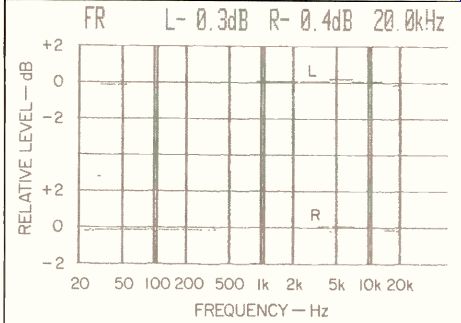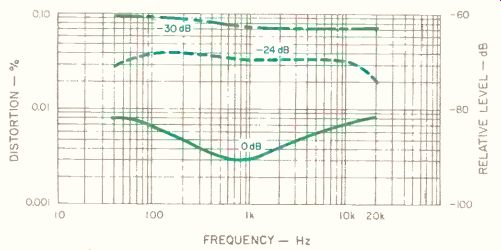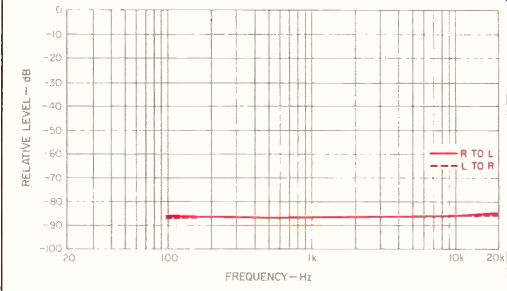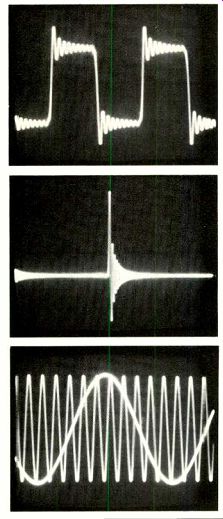
Manufacturer's Specifications
Frequency Response: 5 Hz to 20 kHz, ± 0 5 dB.
S/N: 95 dB.
Channel Separation: 90 dB.
Harmonic Distortion: 0.003% at 1 kHz.
Wow and Flutter: Unmeasurable.
Audio Output Level: 2.0 volts rms.
Headphone Output Level: 28 mW (32 ohms)
Power Consumption: 120 V, 60 Hz, 32 watts.
Dimensions: 16.93 in. (43.0 cm) W x 4.13 in. (10.5 cm) H x 15.08 in. (38.3 cm) D.
Weight: 25.3 lbs. (11.5 kg).
Price: $1,500.00.
Company Address: Sony Drive, Park Ridge, N.J. 07656.
It is less than a year since I first tested a CD player and reported my findings in Audio. That first CD player was a Sony CDP-101. It was also the very first CD player to actually become available to American consumers, having reached the initial selection of Sony dealers in March and April of 1983. Not content with having won the race to the marketplace, Sony has now come up with a second-generation CD player, the CDP-701 ES. It seems that "701" is the company's favorite number for all second-generation high tech products, as witness their PCM-701, the second-generation digital audio processor (for use with VCRs) that we tested a few months ago. The new CDP-701 ES incorporates many programmable features not present on the earlier model but which have found their way into CD players introduced by some of Sony's competitors. The new buttons and displays are all additional to the controls and displays present on the first model, so let's quickly review those basic controls; then I'll tell you about the new ones.
The power switch and "timer play" switch have been shifted to the lower left of the new front panel. After the power switch is pushed, the digital display area to the right of the disc-loading drawer displays the numeral 1. Touch the "Open/Close" button on the disc drawer and it opens smoothly. Drop the disc you want to play into the drawer (no centering, no spindle to fumble with), touch either the "Play" or the "Open/Close" button once again, and the drawer closes quickly, centering the disc on the drive spindle which is inside. If you pressed the "Play" button, disc play begins in a couple of seconds. If you only closed the drawer with the "Open/Close" button, you then have the option of touching either the "Play" button to start that function or of depressing the track-advance button to select any track on the disc. There's a track-reverse mode too; one push of the button brings you back to the beginning of the track being played, while two pushes brings you to the start of the last previous selection, etc. The "Pause" button is located just beneath the "Play" button.
The digital display of the CDP-701 is much larger than that of the earlier CDP-101 and it displays more items. After a disc is loaded into the player, it is automatically scanned and a ruler-like display, calibrated in minutes, appears.
Highlighted markers along the ruler show the approximate time at which breaks between successive tracks occur.
During play, there is a continuously flashing marker that moves along the ruler to indicate the approximate point of play within the track. Time into a track is displayed in minutes and seconds, while a second real-time display tells you how many minutes and seconds of playing time remain on the disc. In addition to displaying track numbers, the display area also shows "Index" numbers. I do not yet own any CD discs which have this "Index" feature, but I have been told that CD discs will incorporate index points within long selections, such as movements of a symphony. You could then access specific sections within the track, as Index 1, 2, 3, etc. within the track divisions.
Additional buttons carried over from the earlier model include double- and triple-arrow fast-forward and reverse buttons, which let you zip forward or back while listening to the program material. These functions are completely analogous to the fast-scan functions now found on most video tape recorders, except that as the buttons are held down, you don't hear a change in pitch of the music, just a fast sampling of what's on the disc so that you can elect to stop at a desired spot. Three repeat-play buttons offer as many options, specifically, repeat of the track being played, re peat play of the entire disc or repeat of specifically designated material (from one point to another) on the disc.
A "Reset" button cancels play at any point, returns the laser pickup to its internal "rest" position and stops the disc's rotation. Adjacent to the elaborate display area is an infrared sensor to which instructions are sent by the wireless remote control unit supplied with the CDP-701. This unit is identical in every way to the one supplied with the earlier model. This slim, hand-held module, powered by two "AA" batteries, duplicates just about all of the front panel functions, including the memory repeat options, fast audible scanning, and track selection. In addition, a 0 to 9 set of numeric buttons allows you to "dial up" any track you would like to hear without having to step through lower or higher numbers to get to it.

Fig. 1--Frequency response, left (top) and right channels, at 0 dB

Fig. 2--Harmonic distortion vs. frequency at levels of 0 dB (bottom curve),
-24 dB (middle curve), and -30 dB (upper curve).

Fig. 3--Channel separation vs. frequency.
New Features
Four totally new programming and access features have been added to the Sony CDP-701 and greatly enhance its versatility. First, there is "Music Scan." When this button is pressed, the player offers you 10 seconds worth of music from each track of the disc, allowing you to "audition" the various selections. When you hear something you like, you have but to touch the "Play" button, and that track will continue playing from that point onward.
The second new feature is known by its acronym, RMS (Random Music Selection). Using a combination of numeric touch buttons, a button labeled "Track" and another touch button labeled "Start," you can program up to eight different tracks to be played in any order that you wish. As the program track numbers are being chosen, the display shows you how many choices you have made thus far, appending a minus sign (- ) to the number, so you won't confuse it with a track number. A "Clear" button cancels all or any part of the program, should you change your mind about what you want to hear or the order in which you want to hear it.
The third new feature allows you to initiate play at any point within any track of a CD disc. This sequence of programming is started by touching a button labeled "Location." This is followed by keying in the desired track number and the minutes and seconds into that track where you want to begin. Alternatively, you can use the fourth feature, the Indexing subcode. The "Start" button initiates the search and begins play at the desired point in the disc. This feature, as well as the other new programming capabilities, are accompanied by appropriately informative displays in the enlarged display area.
The stereo headphone jack, located at the left end of the panel on the CDP-101, has been shifted over to the lower right corner of the panel on the CDP-701, along with a step-type attenuator which adjusts headphone volume in 6-dB steps (to a maximum attenuation of 24 dB) to take care of the different efficiencies of different headphones.
Analog signals are extracted from the rear of the CDP-101 via a pair of phono jacks. There's a "beep" on/off switch which works in conjunction with the hand-held, wireless remote-control unit. If you want the system to "beep" and confirm that remote instructions have been received, leave the switch on. A multi-terminal " Accessory Port" socket is intended for connection to a CRT or video monitor for display of such things as track subcodes, disc table of contents, videotex or teletext. My sources say that a range of such accessories should be available in early to mid 1984.
Measurements
As far as I was able !o tell, very little has changed in terms of circuitry inside the CDP-701, compared with the circuitry of the CDP-101. I am informed by a Sony spokesperson that one major difference involves the use of double decoding, by which is meant that separate D/A decoders are used for the left and right channel information. The earlier approach used a single D/A decoder to alternately decode left and right samples back into the analog domain, after which multiplexing techniques were used to separate the two sets of audio information. Ostensibly, this new approach is sup posed to yield better separation between channels, among other things. Since the older approach yielded separation figures of around 80 dB, I'm not certain that any audible benefits accrue from the new double-decoding approach.
Once again I used the test discs supplied by Philips for evaluating the static performance of the CDP-701 on the test bench. The musical sampler, with its opaque tapered-wedge "scratch," black-dot "dust," and "fingerprint" simulations, was also used to evaluate the error-correction capabilities of the new Sony player. I decided to go back to the Sony test disc I had used in some of my earliest CD player test reports for measuring channel separation, since, for some unexplained reason, Philips did not include separation tests, per se, on their otherwise very comprehensive test disc. Of course, the test signals that the Philips disc offers for THD measurement could be used for checking cross-talk too, since the signals are encoded on only one channel in each track.
Frequency response plots for both the left and right channels of this CD player are shown in Fig. 1. Note that the sensitivity of the amplitude (vertical) scale has been expanded to 2 dB per division. Maximum deviation from absolutely flat response was-0.3 dB for the left channel and -0.4 dB for the right channel at 20 kHz, the highest test frequency of the sweep.
Several tracks of the Philips test record are devoted to measurement of total harmonic distortion over the range of frequencies from 41 Hz to 20 kHz. Furthermore, in a digital audio system, best distortion figures are obtained just below 0-dB record levels, so the disc also includes a series of test tones at -24 and-30 dB with which the tester can mea sure how THD rises with decreasing signal levels. The three curves of Fig. 2 show THD versus frequency at these three different output levels from the player. At mid-frequencies, THD measured 0.003% referred to maximum output. At lower recording levels, as expected, THD increases, al though even at a-30 dB level it was still acceptable with readings of 0.075%. Results were virtually identical for the left and right channels.
Signals at 997 Hz are also provided on the test disc for checking linearity of the playback system. Levels are 0,-1,- 6,-12,- 24,- 60,- 80, and- 90 dB. I detected no significant deviation from perfect linearity until the test got down to-80 dB, which my instruments read as-78.5 dB.
Using the appropriate tracks on my other (Sony) test disc, I plotted channel separation at the four test frequencies it provided. Results are shown in Fig. 3. Separation was around 85 to 86 dB for both channels and remained a high 84 dB at 20 kHz for the left channel and 84.5 dB for the right channel. These readings probably include some residual noise of the test setup, rather than being just the actual cross-talk which was not detectable as such on our oscilloscope display.
Two tracks are provided on the Philips test disc for checking SMPTE-IM. With these, I measured 0.0065% IM at 0 dB level, 0.04% at a-20 dB record level. Signal-to-noise ratio measured exactly-97 dB with reference to 0 dB (maxi mum) output level, A weighted.
Square waves at frequencies of 100 Hz, 400 Hz, 1 kHz, and 5 kHz are provided on the Philips Test Disc, as are various tone bursts, pulse signals, and phase-checking pairs of signals. I found that the 1-kHz square-wave signal is a good one to display (see Fig. 4), since it clearly shows the degree of "ringing" that is produced by the sharp cutoff filter found in this and other players.

Fig. 4 Reproduction of 1-kHz square wave.
Fig. 5 Single-pulse test.
Fig. 6 Phase-linearity test, 2-kHz and 20-kHz signals.
The single pulse incorporated in the Philips discs that I used to evaluate transient response of this player consists of a single sample at full scale, followed by 127 samples at zero amplitude. As is evident in Fig. 5, this test signal was reproduced with a fair amount of ringing, of both positive and negative polarity, following the unit pulse itself.
Of the several phase-check tests available on my Philips test disc, the one that I elected to use is one in which a 2-kHz signal is recorded on one channel while a 20-kHz signal is recorded on the other. In this test the positive-going crossing of the zero-axis of the lower frequency signal is supposed to occur at the same instant that the higher frequency signal crosses the zero axis, also in a positive-going direction. Examining the two sets of sine-waves in Fig. 6 carefully, you will notice that, in fact, the low-frequency signal crosses the zero axis in a positive-going direction a few microseconds ahead of the high-frequency signal's positive crossing of the zero axis. As near as I can tell, the high-frequency signal is displaced relative to the mid-frequency signal by approximately 20 degrees. That works out to a phase-error time delay of around 3 microseconds.
Using the Philips musical test disc with the opaque wedge "scratch," the black-dot "dust" and the "fingerprint" simulations, I noted that the Sony CDP-701 played all the way through the 900-micron width of the wedge with no muting. That's the greatest width of the opaque wedge, and about as good as any error correction system could be expected to perform. Neither did the system mute when playing selections that were covered by any of the three "black dots" meant to simulate dust particles of increasing diameter on the surface of the test disc. As for the finger print simulation, the Sony CDP-701 ignored it completely, playing right through the selections that were marred by this defect as if it weren't even present.
Use and Listening Tests
During the tests of the CDP-701, I was fortunate enough to be able to compare its sonic performance with that of the earlier CDP-101, and I must tell you in all honesty that I could not hear any difference between the two. Both reproduced sound with that special clarity and transparency which has become associated, in my mind at least, with the sound of compact digital audio discs. During my recent trip to Eindhoven (Philips) and Hannover (Polygram Records), I shopped several record stores in Amsterdam and added substantially to my collection of CD discs. Among my new discs is a sampler from Nimbus Records, who specialize in natural sounding recordings, ones not subjected to manipulations such as limiting, compression and multi-mike techniques. Those critics who have been quick to offer negative judgments about various CD players and about the new CD medium itself might do well to listen to some of the cuts on this disc. Others to be recommended are the Philips digital recordings of some Bach organ works, including the well known Toccata and Fugue in D minor, played by Daniel Chorzempa on an organ in the De Bovenkerk Church in Kampen, The Netherlands, and the Bach Brandenburg Concertos with Neville Marriner and the Academy of St. Martin-in-the-Fields. These discs and several others that I listened to on the Sony CDP-701, did justice to the new player-and to CD in general.
As for my specific likes and dislikes concerning the CDP 701, I was particularly pleased with the "Location" feature which allowed me to "get into" a track at a specific location.
Since my tastes run to classical music more than pop, I invariably find that the "tracks" on CD discs are quite long. If I want to hear just a passage instead of an entire movement, it's nice to be able to get to it directly. The scanning feature is welcome too, and will probably be enjoyed even more by those listeners who buy pop CD albums containing as many as 10 to 15 separate tracks. It is a credit to Sony that, even though I was supplied with only a Japanese version of the owner's manual for the CDP-701, I was able to figure out all of the new programming features and how to operate them.
Since my literacy in Japanese is nil, you can surmise that the panel layout of the CDP-701 (ergonomics is the "in" word for panel layout these days) was superb. So was the product . . . and so was the music. As for the dislikes . . . there weren't any!
-Leonard Feldman
(Audio magazine, Sept. 1983)
Also see:
Sony CDP-705ESD Compact Disc Player (July 1987)
Sony CDP-707ESD Compact Disc Player (Equip. Profile, Apr. 1988)
Sony CDP-X77ES CD Player (Jun. 1990)
Sony CDP-620ES CD Player (Sept. 1985)
Sony CDP-610ES CD Player (Nov. 1984)
Sony CDP-650ESD Compact Disc Player (July 1985)
= = = =